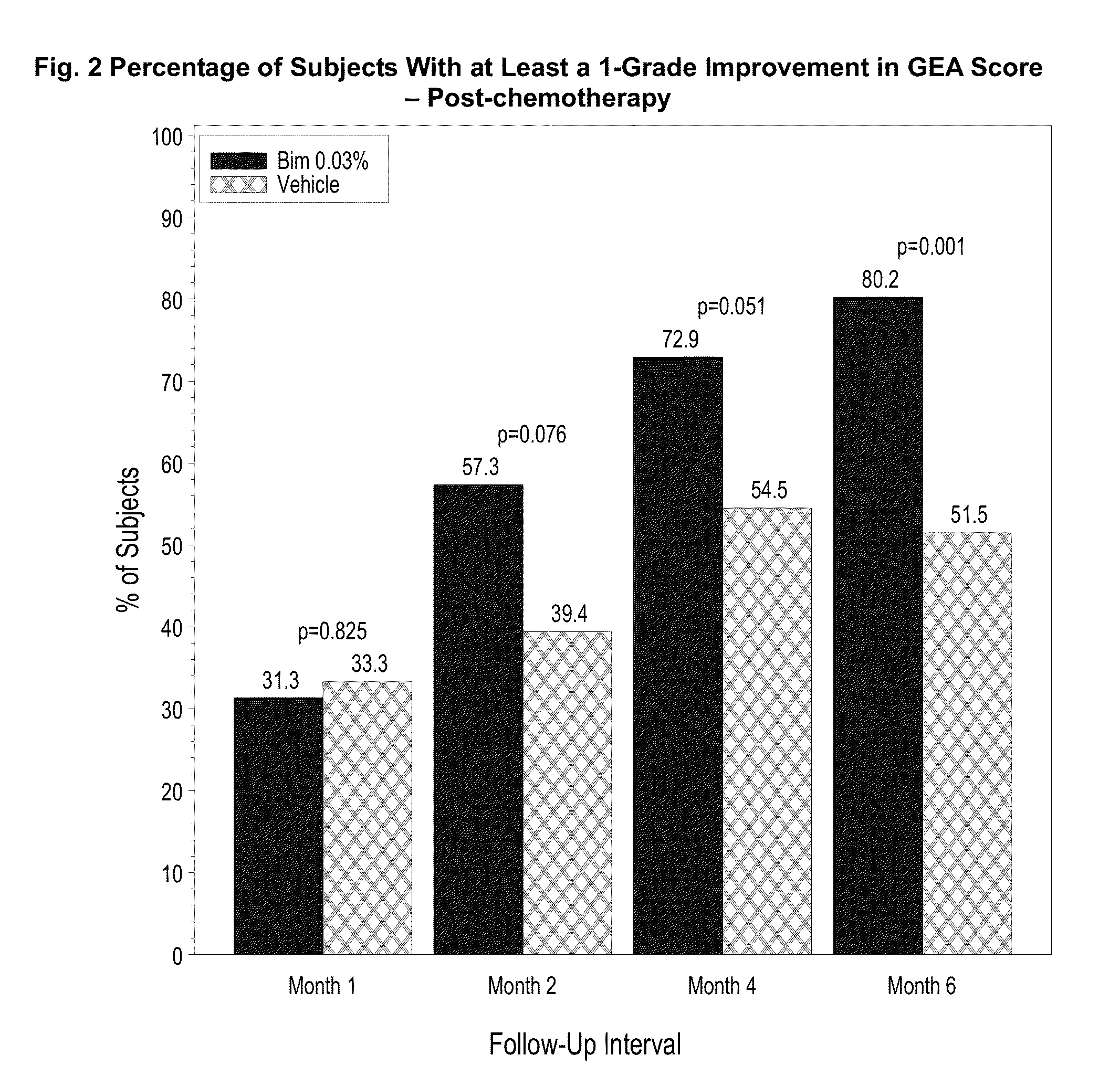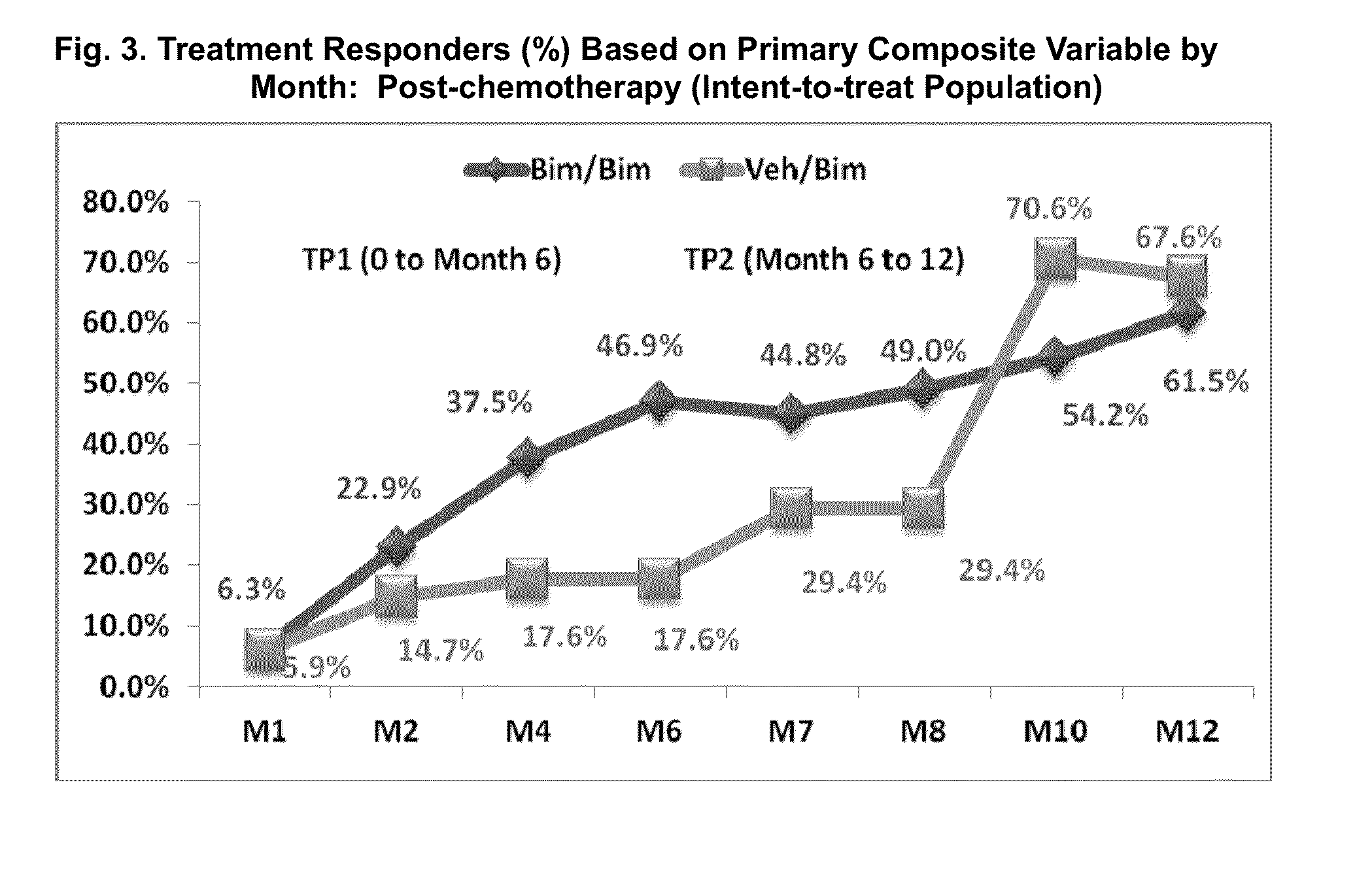Topical treatment for chemotherapy induced eyelash loss or hypotrichosis using prostamide f2 alpha agonists
a technology of prostamide and f2 alpha agonist, which is applied in the field of postchemotherapeutic hypotrichosis treatment, can solve the problems of chemotherapy-induced hair loss, patchy hair loss, damage to the hair follicle components, etc., and achieve the effect of preventing the loss of eyelashes
- Summary
- Abstract
- Description
- Claims
- Application Information
AI Technical Summary
Benefits of technology
Problems solved by technology
Method used
Image
Examples
example 1
[0031]
TABLE IList of Components and Quantitative CompositionConcentrationConcentrationIngredients(% w / v)(mg / mL)FunctionActive ingredientBimatoprosta0.030.3ActiveingredientOther ingredientsBenzalkonium chlorideb0.0050.05PreservativeSodium phosphate 0.2682.68Buffering dibasicheptahydrateagentCitric acid monohydrate0.0140.14Buffering agentSodium chloride0.838.3Tonicity agentHydrochloric acidc and / or Adjust to pH 7.2-7.4pH adjustersodium hydroxidecPurified waterq.s. ad 100%q.s. ad 1 mLVehicle
Clinical Data:
[0032]A clinical study was conducted that demonstrated the clinical benefits of bimatoprost 0.03% solution in treating eyelash loss resulting from chemotherapy treatment.
Study Design and Structure:
[0033]This was a 1-year, multicenter, double-masked, randomized, parallel-group study to evaluate the safety and efficacy of bimatoprost solution 0.03% in increasing overall eyelash prominence following dermal application to the upper eyelid margins in normal adults and postchemotherapy adult...
example 2
[0062]This is a long-term safety and efficacy study of bimatoprost ophthalmic solution 0.03% (LATISSE®) bimtoprost carried out in idiopathic and post-chemotherapy hypotrichosis populations. In this study, eyelash loss from chemotherapy was studied.
Study Design:
[0063]A one-year, multicenter, randomized, double-masked, vehicle-controlled study. Adult post-chemotherapy and idiopathic eyelash hypotrichosis subjects were enrolled based on their score of 1 or 2 on a four point ordinal Global Eyelash Assessment (GEA) scale, and in addition having a low score on a PRO measure associated with ‘psychological impact’ of the condition, a domain-2 of the Eyelash Satisfaction Questionnaire (ESQ). The study involved two treatment periods of six months each. In the first treatment period, subjects for both populations were randomized 3:1 for QD bimatoprost: vehicle treatment. In the second 6-month treatment period, all subjects were moved to bimatoprost treatment, except for a group of bimatoprost ...
example iii
Objective
[0077]To evaluate long-term safety and efficacy of bimatoprost among subjects with idiopathic or chemotherapy-induced hypotrichosis.
Methods:
[0078]This multicenter, double-masked, randomized, parallel-group study included two 6-month treatment periods. Subjects with idiopathic hypotrichosis were randomized to 3 treatment groups: 1) treatment period 1 (TP1) and TP2: bimatoprost; 2) TP1: bimatoprost; TP2: vehicle; and 3) TP1: vehicle; TP2: bimatoprost. Subjects with chemotherapy-induced hypotrichosis were randomized to 2 treatment groups: 1) TP1: bimatoprost or vehicle; and 2) TP2: bimatoprost. The primary endpoint was a composite of at least a 1-grade improvement in investigator-assessed Global Eyelash Assessment (GEA), and at least a 3-point improvement in subject-reported Eyelash Satisfaction Questionnaire (ESQ) Domain 2 (self-perceived confidence, attractiveness, and professionalism) at month 4. Secondary measures included digitally assessed eyelash characteristics (i.e., ...
PUM
| Property | Measurement | Unit |
|---|---|---|
| time period | aaaaa | aaaaa |
| length | aaaaa | aaaaa |
| length | aaaaa | aaaaa |
Abstract
Description
Claims
Application Information
 Login to View More
Login to View More - Generate Ideas
- Intellectual Property
- Life Sciences
- Materials
- Tech Scout
- Unparalleled Data Quality
- Higher Quality Content
- 60% Fewer Hallucinations
Browse by: Latest US Patents, China's latest patents, Technical Efficacy Thesaurus, Application Domain, Technology Topic, Popular Technical Reports.
© 2025 PatSnap. All rights reserved.Legal|Privacy policy|Modern Slavery Act Transparency Statement|Sitemap|About US| Contact US: help@patsnap.com



